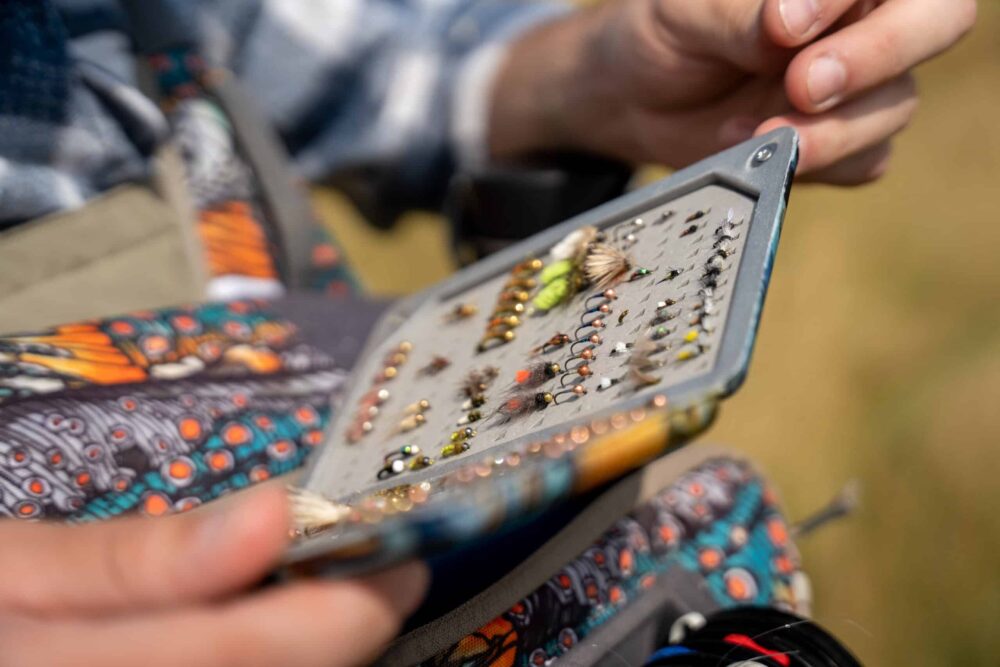When an angler approaches a RareWaters riverbank with a fly box in hand, what fly to choose is a question that needs to be answered. Depending on a variety of factors such as the time of year, water level, and temperature, anglers can expect to encounter certain insects throughout Colorado, Montana, and Wyoming.
How to Choose a Fly
Choosing the correct fly for the situation and knowing how and where to present it is a skill fly anglers develop along the way. Here are some basic pointers to help you choose a new fly, know when to switch flies, and where to use a new fly depending your situation. For this article, I’ll focus two seasons: Spring and Summer.
Selecting New Flies in the Spring
In the Spring, when winter releases its grip on the environment, trout respond accordingly. All trout increase activity with the warmth springtime brings. Rainbows and cutthroat trout spawn in the spring. Brown and brook trout step up their feeding and insect volume increases both above and below the water’s surface. During this increase in feeding activity, trout eat regularly underwater, but they are also starting to look up for activity on the surface. It might be time to start thinking about switching flies.
Shallow water riffles will hold trout feeding on small mayfly nymphs. A size 18 Pheasant Tail nymph imitates the emerging mayflies effectively. The springtime Blue Wing Olive hatch is the first major insect emergence of the year. Incredibly high numbers of emerging insects make fishing a size 16 soft hackle pheasant tail in the middle of the water column easy pickings for rainbow and brown trout.
When the runoff kicks into high gear and the water level increases to a turbid froth, anglers can still satisfy the urge to cast a fly, but they must change their approach. New flies like San Juan worms, brightly colored salmon eggs, and large silhouette stoneflies tumble along the river bottom enticingly. Worms and eggs are food sources that lack locomotion and settle in predictable locations. Anglers should target current breaks, back eddies, and deep, swollen pockets where trout escape the exhausting effects of high water but also where food still comes to them.
With water still high but manageable, anglers have the opportunity to choose the largest of the stoneflies, the Salmonfly. At over three inches in length, salmonflies, provide a huge source of protein after the long, lean winter months. The largest trout of the river will come up to the surface to eat during the salmonfly hatch. Chubby Chernobyls are flies that create a broad silhouette on the surface and draw smashing strikes. Keeping these environmental factors in mind will help guide you when deciding what fly to choose in any particular Springtime scenario.
When to Switch Flies for Summer
In summertime, fly anglers celebrate the season of dry flies. Multiple mayflies emerge across the Rocky Mountain region in the summer. World famous western mayfly hatches would include the well known Green Drake hatch that occurs across Colorado and Wyoming. Large parachute Adams flies can be effective Green Drake imitations.
Other insects fill the air too. Caddis begin to float seductively on the surface. Elk Hair Caddis flies float high and are visible from a distance making them ideal dry flies for summertime anglers. Yellow Sallies hover up towards the sun at the same time as caddis. A yellow Puterbaugh’s foam bodied caddis is a unique crossover fly that covers both insects.
Trout continue to feed consistently on the surface until late summer consumes the days and terrestrial flies come into play. Grasshoppers, beetles and ants become more active in late summer. And predictable western weather blows terrestrials into the river every afternoon. Foam bodied grasshopper flies with rubber legs float, kick, and provoke aggressive strikes from bankside trout. Winged ant flies fished in tandem with another dry terrestrial pattern like a beetle or black cricket will cover two tasty offerings at once. The combinations are endless and deciding which flies to use will depend on your powers of observation. Every great fly fisherman is an amateur entomologist!

A Fly for Every Situation
From fast water riffles to overgrown riverbanks, fly anglers have unique opportunities to try a variety of fly fishing approaches depending on time of year. Streamer fishing, Euro-nymphing, and the sweetest prize: the dry fly eat. Whatever your approach, fly anglers must think through when and where to use a new fly and how the target trout will respond to the new flies they try. Some of that is trial and error, but starting with the seasonal awareness outlined above will put you on the right path.
Classic western style fly fishing is yours to discover on the RareWaters properties across Colorado, Montana, and Wyoming. With the entire stretch of river to yourself, sorting out your fly choices can be done in a relaxed and serene setting. So take a deep breath, look around, consider the time of year and the time of day and crack open your fly box, imagining your strategy for tricking the wily trout below the surface.







